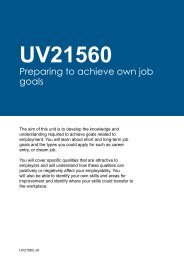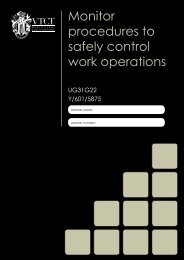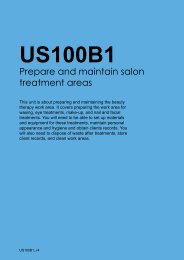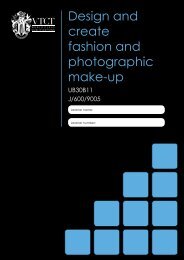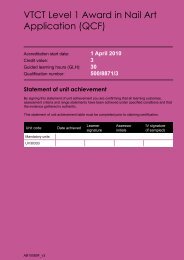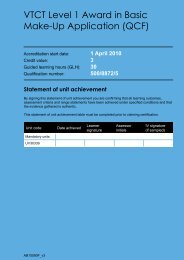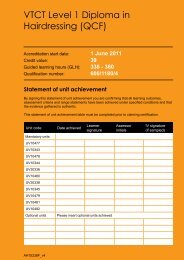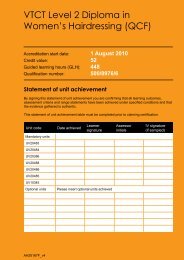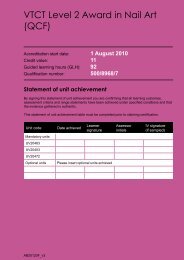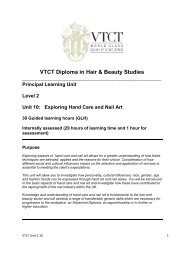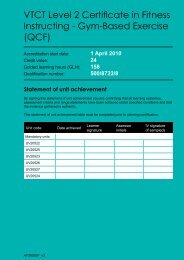Observations - VTCT
Observations - VTCT
Observations - VTCT
Create successful ePaper yourself
Turn your PDF publications into a flip-book with our unique Google optimized e-Paper software.
Unit content<br />
This section provides guidance on the recommended knowledge and skills required to enable you<br />
to achieve each of the learning outcomes in this unit. Your tutor/assessor will ensure you have the<br />
opportunity to cover all of the unit content.<br />
Outcome 1: Be able to communicate and behave in a professional manner<br />
when dealing with clients<br />
Verbal communication: (speaking)<br />
manner and tone, professional, supportive,<br />
respectful, sensitive to client, open<br />
questioning related to treatment.<br />
Advantages – quick, instant response,<br />
client body language.<br />
Disadvantages – no written record, no<br />
time to consider, no paper trail.<br />
Non-verbal communication: eye contact,<br />
body language, listening.<br />
Advantages – written communication,<br />
detailed, recorded, clear, specific,<br />
opportunity to consider, paper trail.<br />
Body language – expression of feelings,<br />
easily identify anger, happiness, confusion.<br />
Disadvantages – written communication,<br />
cannot see reaction, cannot change mind,<br />
no opportunity for discussion.<br />
Body language – cannot hide feelings,<br />
can be a barrier.<br />
Professional manner: Use positive body<br />
language, abide by salon regulations and<br />
codes of conduct, encourage clients to ask<br />
questions, be supportive and respectful, be<br />
sensitive to client’s privacy and personal<br />
details, professional appearance, avoid<br />
inappropriate conversations.<br />
Professional appearance: Clean,<br />
professional uniform, no jewellery or<br />
piercings, hair neatly tied back (fringe<br />
secured), closed-in footwear, personal<br />
hygiene and cleanliness (shower/bath,<br />
cover cuts and abrasions, deodorant or<br />
antiperspirant), oral hygiene (clean teeth,<br />
fresh breath), nails (good condition and<br />
maintained, short, no nail varnish, no nail<br />
extensions).<br />
Professional ethical conduct: Polite,<br />
cheerful and friendly manner; friendly facial<br />
expressions, positive attitude, eye contact,<br />
open body language, client relations (not<br />
argumentative, confidentiality), respect for<br />
colleagues and competitors, avoid gossip,<br />
pride in work, honesty, integrity, punctuality,<br />
employer and client loyalty.<br />
Consultation communications:<br />
Establish client requirements<br />
and therapist recommendations,<br />
give appropriate advice if client is<br />
contra-indicated, client satisfaction, client<br />
expectations, suitability and aftercare,<br />
prevent contra-actions, courteous,<br />
eye contact, verbal communication,<br />
non-verbal communication, signatures<br />
of client and therapist (legal document;<br />
insurance claims, acknowledgement of<br />
recommendations), avoid conflict between<br />
a client and therapist, visual, manual,<br />
question, listen, client card reference, use<br />
a range of related terminology linked to<br />
treatment being performed.<br />
Client requirements: Age, cultural<br />
background, special needs, satisfied<br />
clients, dealing with dissatisfied clients, all<br />
clients treated equally, clear, direct, action<br />
taken where necessary, written record.<br />
UV30468 31



